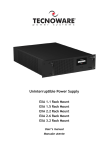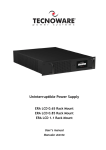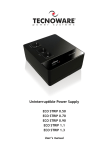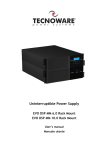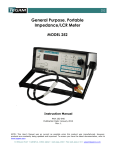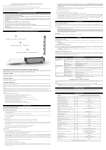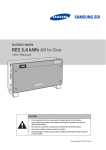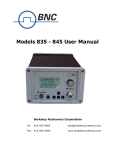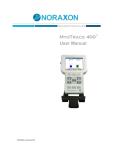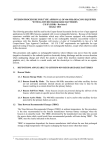Download [ENG-ITA] User's Manual UPS EVO DSP PLUS MM 1.2-2.4
Transcript
Uninterruptible Power Supply EVO DSP PLUS MM 1.2 EVO DSP PLUS MM 2.4 EVO DSP PLUS MM 3.6 User’s manual Manuale utente Index User’s Manual - English ........................................................................ 1 Safety Warnings ................................................................................ 1 1 Introduction ................................................................................. 2 2 General Characteristics ................................................................... 3 3 Receipt and site selection ................................................................ 3 4 Operating Modes ........................................................................... 4 4.1 4.2 4.3 4.4 4.5 4.6 NORMAL Mode .......................................................................... 5 BATTERY Mode ......................................................................... 5 BYPASS Mode ........................................................................... 5 STAND-BY Mode ........................................................................ 6 ECO Mode ............................................................................... 6 CONVERTER FREQUENCY Mode ...................................................... 7 5 EXTERNAL DESCRIPTION .................................................................. 7 5.1 Front Panel ............................................................................. 7 5.1.2 5.1.3 5.2 Buttons .................................................................................... 10 Acoustic Alarm ........................................................................... 11 Rear Side.............................................................................. 11 6 Electrical Installation ..................................................................... 12 6.1 Installation ........................................................................... 13 7 First Start Up .............................................................................. 14 8 Functioning ................................................................................ 15 8.1 8.2 8.3 8.4 8.5 8.6 8.7 Turning ON and OFF ................................................................. 15 Low Battery and Automatic Restart ............................................... 15 Load Testing .......................................................................... 16 Static Bypass ......................................................................... 16 Battery Test .......................................................................... 17 Operation in Warning Status ....................................................... 17 Operation in Fault Mode ............................................................ 18 9 Communication Interfaces .............................................................. 18 10 Technical Characteristics ................................................................ 19 11 Maintenance ............................................................................... 21 11.1 UPS Cleaning ......................................................................... 21 11.2 Battery ................................................................................ 21 11.3 Operator Safety ...................................................................... 21 12 Troubleshooting ........................................................................... 22 Conformity to the European Directives ................................................... 24 Product Disposal ............................................................................... 24 Lead Batteries ................................................................................. 24 ENGLISH User’s Manual - English Safety Warnings Read this manual carefully and completely before installing and using the EVO DSP PLUS MM Uninterruptible Power Supply, which, from here after, will also be referred to as UPS. The UPS must be used only by properly trained personnel. To ensure correct and safe operations, it is necessary that operators and maintenance personnel observe the general safety Standards as well as the specific instructions included in this manual. Risk of electric shock: do not remove the cover. The UPS contains internal parts which are at a high Voltage and are potentially dangerous, capable of causing injury or death by electric shock. There are no internal parts in the UPS which are user serviceable. Any repair or maintenance work must be performed exclusively by qualified technical personnel authorized by producer. TECNOWARE declines any responsibility if this warning is disregarded. The electric installation has to be done by qualified personnel. Follow all the Safety Standards (CEI Standards in Italy or IEEE elsewhere) for the Input/Output connections and for the right section of Input/Output cables. It is compulsory to ground the UPS according to Safety Standards. Risk of electric shock at the Output lines when the UPS is ON. Risk of electric shock at the Output lines while the unit is connected to the AC utility line. For respect of the Safety Standards is necessary the presence of a differential circuit breaker between UPS Output lines and the loads. We recommend to use a dedicate AC power line for the UPS. Do not obstruct ventilation slots or holes and do not rest any object on top of the UPS. Do not insert objects or pour liquids in the ventilation holes. Install the UPS indoors, in a protected, clean and moisture-free environment. Do not expose to the direct sun light. Do not keep liquids, flammable gases or corrosive substances near the UPS. UPS EVO DSP PLUS 1.2-2.4-3.6 MM 1 User’s manual ENGLISH 1 Introduction The UPS EVO DSP PLUS MM (UPS means Uninterruptible Power Supply) is the result of constant technological research aimed at obtaining the best performance at the lowest cost. EVO DSP PLUS MM is an advanced ON-LINE UPS built specifically to protect your computer from any irregularities in the AC line (for example blackouts, brownouts, over voltages, micro-interruptions), which often cause damage to hardware and software. All that is possible because EVO DSP PLUS MM is a Double-Conversion ON-LINE UPS. Under normal AC line condition EVO DSP PLUS MM provides an automatic Output Voltage regulation from the Rectifier and Inverter blocks and filters out frequently occurring electrical disturbances (high Voltage transients, spikes, interferences, etc.), this protecting the devices connected to its outlets. During a power failure, EVO DSP PLUS MM continues supplying adequate AC power (with a true sine wave) to all connected devices through its internal batteries and by its DC/AC converter (Inverter). EVO DSP PLUS MM protects the devices from accidental overload or Inverter fault by an Automatic Bypass that directly connects the AC Input line with its outlets. EVO DSP PLUS MM models are factory-equipped with USB interfaces, which may be used for notify to a computer a power failure or a Low Battery condition: this allows automatic data backup during an extended blackout with the most common operating systems (Windows, Linux, Unix, etc). Thanks to Interfaces, UPS EVO DSP PLUS MM can communicate the several made measurements (Input/Output Voltage, batteries, absorption, Frequency, etc.), and can also be programmed in order to start-up or shutdown automatically at fixed times. Read this manual carefully before using the EVO DSP PLUS MM; it includes important safety warnings and useful advices for correct use and installation. EVO DSP PLUS MM is constantly being developed and improved: consequently, your unit may differ somewhat from the description contained in this manual. This manual includes the following models: • EVO DSP PLUS MM 1.2 (1.2 KVA) • EVO DSP PLUS MM 2.4 (2.4 KVA) • EVO DSP PLUS MM 3.6 (3.6 KVA) In this manual EVO DSP PLUS MM will simply be referred to as UPS. EVO DSP PLUS MM models are made from a single unit that contains the electronics parts and the batteries. User’s manual 2 UPS EVO DSP PLUS 1.2-2.4-3.6 MM ENGLISH 2 General Characteristics EVO DSP PLUS MM has all the advanced features which guarantee maximum reliability and safety: • Double-Conversion ON-LINE Transformerless technology • Sinusoidal wave generated by an IGBT Inverter • Output Voltage regulation ±2% • Protection from overload and short circuits • Automatic Bypass to protect from accidental overload or Inverter fault • Start-up even under Mains OFF conditions • Automatic protection when Battery is low • Automatic restart, following an automatic shut-down due to Low Battery, once AC utility power comes back on • Selectable Input Frequency (50 or 60 Hz) • Graphic LCD panel for visualization of the Input and Output Voltage measurements, batteries Voltage, percentage of load, frequency, alarms, overload, fault and path of energy flow • Acoustic signals of various kinds indicating alarm situations • Available settings of all the UPS parameters by user through front panel pushbuttons and graphic LCD panel • SNMP Adapter (optional) • Communication with the computer through USB interfaces • ECO functioning mode (selectable) • Frequency Converter functioning mode (selectable) • High efficiency • Maximum reliability • Smart design and easy to use 3 Receipt and site selection Carefully remove the UPS from its packaging, and carry out a meticulous inspection. We recommend keeping the original packaging in a secure place, in case you need to send the UPS for maintenance purposes. In case of transport damage, notify the carrier and dealer immediately. We recommend paying attention to the below points in order to choose a correct placement for your UPS: • The UPS is designed to operate in a protected environment (e.g. offices). We therefore recommend installing it in a place with very little or no humidity, dust or smoke. • When the UPS is brought from a cold place to a warmer place, humidity in the air may cause condensation in the UPS. In this case, allow UPS to stand for two hours in the warmer place before beginning with the installation. UPS EVO DSP PLUS 1.2-2.4-3.6 MM 3 User’s manual ENGLISH • In all circumstances, see the “Technical Characteristics” chapter for environmental specifications and check that the selected area meets these criteria. • During normal operation the UPS discharges a minimal amount of heat. So it is necessary to leave at least 10 cm of unobstructed space all around the UPS in order to keep it properly ventilated. • Do not obstruct ventilation holes. • Do not insert objects or pour liquids in the ventilation holes. • Do not rest any object on top of the UPS. • Do not keep liquids, flammable gases or corrosive substances near the unit. • Install the UPS on a properly tiled floor. Avoid the installation on a floor that is not tiled flat. 4 Operating Modes NORMAL MODE BATTERY MODE BYPASS MODE Figure 1 – Operating modes User’s manual 4 UPS EVO DSP PLUS 1.2-2.4-3.6 MM ENGLISH 4.1 NORMAL Mode The UPS typically works in Normal mode: Input mains power is available and its amplitude is within specifications. Please refer to figure 1. After the filter has eliminated any high Frequency interference present on the mains, the AC Input line is rectified and conditioned in the Rectifier block (AC/DC conversion); the continuous power now enters into the Inverter block and is then reconverted into alternated power (DC/AC conversion), overcoming the Automatic Bypass and feeding the load after an extra filtration. At the same time the UPS recharges the batteries through the Battery Charger block. Please refer to figure 2, which describe the UPS front panel. The Normal mode is identified by: • 4.2 The graphic LCD panel shows the path of energy flow during Normal mode. BATTERY Mode During operation in Normal mode, if the UPS finds the Mains OFF condition (due to a Blackout or Overvoltage/Brownout), it then switches into Battery mode. In this case, the batteries supply the required Output power thanks to the DC/AC conversion carried out by the Inverter. The UPS switches back to Normal mode a few seconds after AC Input power is restored or Voltage comes back to internal specifications. Please refer to figure 1. The Battery mode is identified by: • The graphic LCD panel shows the path of energy flow during Battery mode. • An acoustic signal every 4 seconds. 4.3 BYPASS Mode In Bypass mode, the AC Input line is directly connected with the UPS outlets by an Automatic Bypass. As indicated in figure 1, in Bypass mode the UPS recharges the batteries. During Normal mode, the UPS switches automatically to Bypass mode as a consequence of accidental overload or Inverter fault thus protecting the supplied devices. When the UPS is working in Normal mode it is possible to switch the UPS by pressing continuously ON/MUTE and SELECT buttons at the same time for at least 5 seconds, as explained into chapter 5. UPS EVO DSP PLUS 1.2-2.4-3.6 MM 5 User’s manual ENGLISH The Bypass mode is identified by: • The graphic LCD panel shows the path of energy flow during Bypass mode. • An acoustic signal every 10 seconds. During Bypass mode, loads are fed directly from AC Input line. Therefore no protection against AC Input line disturbances or interruptions is present. 4.4 STAND-BY Mode If the UPS is in Stand-by mode, it is “inactive”. In Stand-by mode the Inverter is off and there is not Output power but the UPS is not completely off: indeed the UPS recharges the batteries regularly and the graphic display is ON. If the OFF button is pressed when the UPS is in Normal mode, the UPS switches in Stand-by mode. If the UPS is in Stand-by mode and the AC Input line is removed from UPS, then the UPS switches completely off. The Stand-by mode is identified by: • 4.5 The graphic LCD panel shows the path of energy flow during Stand-by mode. ECO Mode It is possible to select the ECO mode to save energy and to increase the efficiency of the UPS. The ECO mode uses the Bypass to feed the loads. The UPS will operate as in Bypass mode whenever the Frequency/waveform/RMS value of AC Input line mains Voltage is within their tolerance limits. If the AC Input line Voltage goes beyond these limits, the UPS switches into normal operation. Please contact Technical Service for the instruction to enable the ECO mode; by default the ECO mode is disable. ECO mode does not provide perfect stability in Frequency/waveform/RMS value of the Output Voltage like in Normal mode. Thus, the use of this mode should be carefully executed according to the level of protection required by the application. The ECO mode is identified by: • The graphic LCD panel shows the path of energy flow during ECO mode (the “ECO” icon is ON). User’s manual 6 UPS EVO DSP PLUS 1.2-2.4-3.6 MM ENGLISH 4.6 CONVERTER FREQUENCY Mode It is possible to select the Converter Frequency mode to work with the Output Frequency different from the Input Frequency. For example it is possible to work with 60 Hz Input Frequency and 50 Hz Output Frequency or 50Hz Input Frequency and 60 Hz Output Frequency. Please contact Technical Service for the instruction to enable the Converter Frequency mode; by default Converter Frequency mode is disable, and the Output Frequency will synchronize automatically with the Input Frequency; by default the Converter Frequency mode is disable. The Converter Frequency mode is identified by: • The graphic LCD panel shows the path of energy flow during Converter Frequency mode. • The “CF” characters are ON. 5 EXTERNAL DESCRIPTION 5.1 Front Panel The front panel informs the user about operating status, alarm conditions and measurements. It also provides access to controls and configuration parameters. Front panel shown below consists of two parts: 1. Graphic LCD panel provides complete information about the energy flow path and existing alarms, Load and Battery level, Input, Output and Battery measurements. 2. 3 buttons enables the user to turn ON/OFF the UPS and to make selections of the functioning parameters. ON / MUTE SELECT OFF/ENTER Figure 2 – Front panel UPS EVO DSP PLUS 1.2-2.4-3.6 MM 7 User’s manual ENGLISH 5.1.1 Graphic LCD Panel Please refer to figure 3. Input & Battery Voltage Info Backup Time Info Fault Info Buzzer Info Battery Info Output Voltage Info Load Info Mode Operation Info Figure 3 – Graphic LCD Panel User’s manual 8 UPS EVO DSP PLUS 1.2-2.4-3.6 MM ENGLISH Graphic LCD Panel Function Backup time information Indicates how much time has passed in Battery mode. H: hours, M: minutes, S: seconds Fault information Indicates the warning that a fault has occurred. Indicates the Fault codes, and the codes are listed in the “Fault Table” of chapter 8. Mute operation Indicates that the UPS alarm is disabled (muted). Output Voltage information Indicates the Output Voltage or Frequency. Vac: Output Voltage, Hz: Output Frequency Load information Indicates the load level by 0-25%, 26-50%, 51-75%, and 76-100%. Indicates Overload. Indicates the load or the Output is short-circuited. Mode operation information Indicates the UPS connects to the mains. Indicates the Battery is working. Indicates the Bypass circuit is working. Indicates the ECO mode is enabled. Indicates the Inverter circuit is working. Indicates the Output is working. UPS EVO DSP PLUS 1.2-2.4-3.6 MM 9 User’s manual ENGLISH Graphic LCD Panel Function Battery information Indicates the Battery capacity by 0-25%, 26-50%, 51-75%, and 76-100%. Indicates the Battery is faulty or defective. Indicates Low Battery level and Low Battery Voltage. Input and Battery Voltage information Indicates the Input Voltage or Frequency or Battery Voltage. Vac: Input Voltage, Vdc: Battery Voltage, Hz: Input Frequency 5.1.2 Buttons Functions of the buttons are given below: Button Function Turn ON the UPS: press and hold ON/MUTE button for at least 3 seconds to turn ON the UPS. ON/MUTE Mute the acoustic alarm: when the UPS is in Battery mode, press and hold this button for at least 5 seconds to disable or enable the acoustic alarm. But it’s not applied to the situations when warnings or errors occur. Test Battery: press and hold ON/MUTE button for at least 5 seconds to perform the Battery Test while the UPS is in Normal mode. SELECT Select the measurements on the graphic display: by pressing the SELECT button it is possible to choose the electrical parameter to be displayed (Input Voltage, Input Frequency, Battery Voltage, Output Voltage, Output Frequency). If the button is not pressed for at least 10 seconds, then the default parameter will came back on the graphic display (the default parameters are Input Voltage and Output Voltage). OFF/ENTER Turn OFF the UPS: press and hold ON/MUTE button for at least 3 seconds to turn OFF the UPS. By pressing this button while the UPS is in Normal mode, the UPS will go to Stand-by mode; by pressing this button while the UPS is in Battery mode, the UPS will switch OFF completely. ON/MUTE + SELECT Switch to Bypass mode: when the UPS is functioning in Normal Mode, press ON/MUTE and SELECT buttons simultaneously for at least 5 seconds. Then UPS will enter to Bypass mode. This action will be ineffective when the Input voltage is out of the acceptable range. User’s manual 10 UPS EVO DSP PLUS 1.2-2.4-3.6 MM ENGLISH 5.1.3 Acoustic Alarm Note: UPS status Acoustic Alarm OFF Battery Mode Beeping once every 4 seconds YES Low Battery Beeping once every second Overload Beeping twice every second Fault Mode Beeping continuously Bypass Mode Beeping once every 10 seconds OFF = YES : means that the buzzer can be muted or stopped, by pressing ON/MUTE button. OFF = NO 5.2 NO : means that the buzzer can NOT be muted or stopped Rear Side 1 1 2 3 2 7 6 3 5 6 5 4 8 4 EVO DSP PLUS MM 1.2-2.4 KVA Figure 4 – Rear Side EVO DSP PLUS MM 3.6 KVA 1. Computer Interface (USB connector): it is the communication USB port. 2. Slot for SNMP Interface (optional), replacing USB. 3. Telephone Protection (RJ11/RJ45 IN/OUT connectors): to protect and filter a phone line, an ADSL or a LAN (TNV-3 type connections). 4. Grounded AC Input power socket: IEC C14 type for EVO DSP PLUS 1.2-2.4 MM and IEC C20 type for EVO DSP PLUS 3.6 MM; to connect the UPS to the AC utility line by the included power cord. 5. Input Circuit Breaker: it goes off in Overload or short-circuit condition; push the external button of the Circuit Breaker to reactivate it. 6. Grounded Output Receptacles: IEC C13 type. 7. Output Circuit Breaker. It goes off in overload or short-circuit condition; push the external button of the Circuit Breaker to reactivate it. 8. Grounded Output Power Receptacle: IEC C19 type; For connecting an Output power line to supply all the devices to be protected. UPS EVO DSP PLUS 1.2-2.4-3.6 MM 11 User’s manual ENGLISH 6 Electrical Installation The electrical installation has to be done by qualified personnel. Follow all the Safety Standards (CEI Standards in Italy or IEEE elsewhere) for the Input/Output connections and for the right selection of Input/Output cables. For safety we recommend using external circuit breakers between Input mains and UPS AC Input line and between UPS Output lines and the loads. The circuit breakers should be qualified with leakage current protective function (leakage current < 30 mA). For the Input/Output connections use ONLY the included power cables or cables with the same power ratings. TECNOWARE declines any responsibility if this warning is disregarded. The EVO DSP PLUS MM models are made of a single unit design that contains the electronic parts and batteries. Before starting the installation procedure, be sure that: 1. The AC Input Voltage for the UPS has been removed. 2. The UPS is completely OFF (only if graphic LCD panel is OFF). The Neutral is not through. Is necessary to put a label, as the following one, into the AC input distribution box. To guarantee UPS normal operation, before connecting devices to the UPS, please verify that ground and neutral lines of the connected devices are not short circuited. See the image below. LINE LINE NEUTRAL DEVICE UPS NEUTRAL GND User’s manual 12 UPS EVO DSP PLUS 1.2-2.4-3.6 MM ENGLISH If neutral line and ground line are short circuited, please add isolation transformer between UPS and devices. See the image below. NEUTRAL LINE LINE LINE ISOLATION UPS DEVICE TRANSFORMER NEUTRAL NEUTRAL GND Never connect neutral line of input to neutral line of output. Otherwise, it will cause the damage of the UPS. See the image below. INPUT OUTPUT LINE LINE UPS NEUTRAL 6.1 NEUTRAL Installation We advise you to follow the steps below explained: 1. Through the included power cable connect the UPS Input socket to the AC line outlet (see figure 4). It is mandatory to ground the AC line outlet according to the Safety Standards. Carefully check the grounding of AC line outlet. 2. Connect the devices to be supplied to the UPS outputs, by using only the included cables. Be sure all the devices have the main switch in OFF position. UPS EVO DSP PLUS 1.2-2.4-3.6 MM 13 User’s manual ENGLISH It is compulsory to ground the UPS according to the Safety Standards. The case of the UPS is internally connected to the ground terminal (GND) of the IN/OUT terminals, in order to guarantee safety to the user. To guarantee safety it is necessary to be sure that the local electric plant is supplied with GROUND (in compliance with the Safety Standards), and that a valid connection is guaranteed between the GROUND of the UPS and the GROUND of the local electric plant. Any interruption of the GROUND conductor is absolutely prohibited. Risk of electric shock at the Output lines if the UPS is ON, even when the UPS is not connected to AC utility line. Risk of electric shock at the Output lines while the unit is connected to the AC utility line. Risk of electric shock: do not remove the cover. The UPS contains internal parts which are at a high Voltage and are potentially dangerous, capable of causing injury or death by electric shock. There are no internal parts in the UPS which are user serviceable. Any repair or maintenance work must be performed exclusively by qualified technical personnel authorized by TECNOWARE. TECNOWARE declines any responsibility if this warning is disregarded. Disregard for these warnings may lead to a risk of electric shock to operators. 7 First Start Up Turning the UPS ON is very easy. Nevertheless we recommend that, on First Start Up, the following procedure is observed for greater safety. 1. Be sure all the devices connected to the UPS outputs have the main switch in OFF position. 2. Restore the AC Input line for the UPS; be sure that the AC utility power is available, and that its voltage and frequency are within the specifications. 3. As a consequence of point 2, the UPS turns on the graphic display and goes in Stand-by mode: the UPS recharges only the batteries and doesn’t supply Output power. Check the graphic display shows the path of energy flow during Stand-by mode. 4. Press ON/MUTE button for at least 3 seconds: the UPS emits a brief acoustic signal and performs a functioning SELF-TEST. After some seconds the UPS starts to work in Normal Mode and the graphic LCD panel will show the path of energy during Normal mode. 5. Simulate a black-out by removing the AC Input line. The UPS starts working in Battery mode: the graphic LCD panel will show the path of energy during Battery mode. Moreover UPS emits a brief acoustic signal every 4 seconds. When Battery level is ending the acoustic signal will be emitted every 1 second. 6. Restore the AC Input line: after few seconds the UPS turns back in Normal mode. 7. The UPS has passed first start up check: now turn ON the devices (one by one) to be supplied by UPS, checking the UPS doesn’t report Overload information on the graphic LCD panel and all the devices are working regularly. By graphic display check if the Output load percentage is less than 100%; otherwise it is necessary to remove part of the loads at the Output lines. Before using the UPS normally, leave it in Normal mode for in order to charge Battery completely (the UPS charges Battery also in Bypass mode or in Stand-by Mode). The batteries reach the 90% of their capacity after about 4 hours of recharge. User’s manual 14 UPS EVO DSP PLUS 1.2-2.4-3.6 MM ENGLISH 8 Functioning 8.1 Turning ON and OFF Let’s see carefully the consequences of the pressure of ON/MUTE and OFF buttons. The UPS is in Stand-by mode (the Inverter is OFF); if the ON/MUTE button is pressed, after few seconds the Inverter starts and the UPS switches in Normal mode. The UPS is in Normal mode (the Inverter is ON); if the OFF button is pressed, the Inverter turns OFF and the UPS switches in Stand-by mode. To turn completely OFF the UPS please do the following steps: Put the UPS in Stand-by mode by pressing the OFF button Disconnect the AC Input Voltage for the UPS. The graphic LCD panel is OFF only when the UPS is completely OFF. If UPS is used daily, it is recommended to leave the UPS connected to the AC Input line and use the ON/MUTE and OFF buttons on the front panel to activate/deactivate the Inverter. If the UPS has to be turn OFF completely for several days, it is recommended to disconnect the AC Input line for the UPS and then press the OFF button. If the ON button is pressed when AC Input line is not present, the UPS switches ON even, and works in Battery mode after some seconds. If the OFF button is pressed when AC Input line is not present, then the Inverter switches OFF and consequently there will be no Output power. 8.2 Low Battery and Automatic Restart The UPS reaches the Low Battery condition whenever, during working in Battery mode, the batteries reach a charge level allowing the connected devices to operate for few minutes more. The UPS warns operators of Low Battery by lighting of the LOW BATT. icon on the graphic LCD and by emitting an acoustic signal every second. If AC Input does not come back on within few minutes, the UPS shuts-down automatically thus preventing the batteries from discharging excessively; the UPS stops supplying Output power, deactivates control panel indication and goes to a waiting state. Once AC Input comes back on, the UPS restarts automatically and after 4 seconds it goes back to work in Normal mode. After a complete discharge, the UPS needs 4 hours to recharge completely the batteries. The UPS recharges batteries automatically if it works in Normal mode, in Bypass mode or in Stand-By mode. UPS EVO DSP PLUS 1.2-2.4-3.6 MM 15 User’s manual ENGLISH 8.3 Load Testing The UPS indicates the Output Load level by graphic LCD (on the right side as described in the chapter 5). When the Output load is higher then nominal value the UPS warns of Overload condition by graphic LCD and by acoustic alarm as described in the “Warning Table” and in the “Troubleshooting” chapter. The UPS warns of an Overload less than 110% by acoustic alarm. An Overload between 110% and 130% is accepted for about 30 seconds and after UPS switches automatically to the Bypass mode. The UPS switches immediately to the Bypass mode if the Overload is higher than than 130%. Once the requested power is back within range, the UPS switches automatically to the Normal mode. Make sure that the UPS never indicates Overload condition. Do not connect a load greater than rated value to the UPS (see POWER specifications in the chapter “Technical Characteristics”), as this may damage the unit. In this case the warranty is void. 8.4 Static Bypass During Normal mode functioning it is possible to switch the UPS in Bypass mode, by pressing at the same time ON/MUTE and SELECT buttons at least 5 seconds, as explained into chapter 5. The Bypass mode, named also Static Bypass, is useful while performing maintenance or service on the UPS. The Static Bypass, used together with an external Manual Bypass device, enables the user to isolate the electronic circuitry of the UPS from the mains and from the load, and to remove the UPS without interrupting the power by connecting the load directly to the mains. Maintenance and service may only be performed by authorized technical personnel. During Static Bypass, loads are fed directly from Bypass mains. Therefore no protection against mains disturbances or interruptions is present. User’s manual 16 UPS EVO DSP PLUS 1.2-2.4-3.6 MM ENGLISH 8.5 Battery Test It is possible to check the Battery Status when the UPS is running in Normal mode/ECO mode, by performing a Battery Test. To perform the Battery Test, press the ON/MUTE button continuously for at least 5 seconds. The Battery Test starts immediately and it finishes after some seconds. If the batteries pass the test, no alarm will be shown. During the Battery Test, the graphic LCD and buzzer indication will be the same as at Battery mode. To keep the system reliable, the UPS will perform the Battery Test automatically once per week. User also can set Battery Test through monitoring software. 8.6 Operation in Warning Status During a warning condition the buzzer beeps once every second, it means that there are some problems for UPS operation. Users can get the Fault code from graphic LCD panel. Please check the “Troubleshooting” chapter for details. Below you can see the “Warning Table”, with the correspondence between each warning and the relative signals (icons on graphic LCD and acoustic alarm) for the user. Some acoustic alarms can’t be muted unless the error is fixed. Please refer to chapter 5 for the details. WARNING ICON (flashing) ACOUSTIC ALARM Low Battery Beeping every second Overload Beeping twice every second Battery Unconnected Beeping every second Over Charge Beeping every second Reversed phase for AC Input Line Beeping every second Fan failure/Over temperature Beeping every second Over temperature Beeping every second Battery Charger failure Beeping every second Bypass Voltage out of range Beeping every second Warning Table UPS EVO DSP PLUS 1.2-2.4-3.6 MM 17 User’s manual ENGLISH 8.7 Operation in Fault Mode When Fault led illuminates and the buzzer beeps continuously, it means that there is a fatal error in the UPS. Users can get the Fault code from display panel. Please check the “Troubleshooting” chapter for details. Please check the loads, wiring, ventilation, mains supply, Battery and so on after the fault occurs. Don’t try to turn ON the UPS again before solving the problems. If the problems can’t be fixed, please contact Technical Service immediately. In case of emergency, please disconnect the connection from mains supply, external Battery, and Output immediately to avoid further risk or danger. Below you can see the “Fault Table”, with each Fault event and the relative FAULT code/icon on graphic LCD for the user’s information. FAULT EVENT FAULT CODE ICON FAULT EVENT FAULT CODE ICON Vdc Bus Start failure 01 None Low Inverter Voltage 13 None Vdc Bus Over 02 None Inverter Output short-circuit 14 Vdc Bus Under 03 None Battery Voltage too High 27 Vdc Bus Unbalance 04 None Battery Voltage too Low 28 Inverter Soft Start failure 11 None Over Temperature 41 High Inverter Voltage 12 None Overload 43 None Fault Table 9 Communication Interfaces The UPS is factory-equipped with USB Communication Interfaces. On the UPS rear side there are the connections of the Interfaces. The USB signals are all isolated through photo-couplers from the dangerous voltages that are present inside the UPS. Connecting to the Web site www.tecnoware.com, it is possible to download, free of charge, the update UPS management Software, compatible with the most popular Operative Systems. It is possible to use a SNMP (Single Network Management Protocol) Interface to connect the UPS to a LAN (Local Area Network). The SNMP interface is optional. We advise you to follow the steps below explained to install the interface correctly: 1. Remove the USB interface (#2, figure 4) that covers the slot for SNMP interface. 2. Put the SNMP Interface into the slot and fix it with screws. 3. Connect the LAN cable to SNMP interface and follow the included instruction to make the interface working well. User’s manual 18 UPS EVO DSP PLUS 1.2-2.4-3.6 MM ENGLISH 10 Technical Characteristics UPS EVO DSP PLUS MM Model Power Nominal Active Power 1.2 2.4 3.6 1200 VA 2400 VA 3600 VA 840 W 1680 W 2520 W Power Factor 0.7 Technology On-Line Double Conversion Transformerless Dimension (W x H x D) 15 x 22 x 40 cm Net Weight 12 kg 19 x 31,8 x 42 cm 18 kg 30 kg INPUT Nominal Voltage Single Phase 208/220/230/240 Vac 110 Vac ± 5% (at 0-60% load) 120 Vac ± 5% (at 60-70% load) Lower Limit (transfer to Battery mode) 140 Vac ± 5% (at 70-80% load) 160 Vac ± 5% (at 80-100% load) Voltage Range for Normal mode Lower Limit (come back to Line mode) Upper Limit (transfer to Battery mode) Upper Limit (come back to Line mode) 175 Vac ± 5% 300 Vac ± 5% 290 Vac ± 5% Nominal Frequency 50/60 Hz (automatic selection) Frequency Range (Normal mode) 47 ~ 53 Hz / 57 ~ 63 Hz Input Power Factor 0.99 (at 100% Load) OUTPUT Nominal Voltage Single Phase 208/220/230/240 Vac (selectable) Voltage Regulation ±2% Inverter Waveform True Sinewave Nominal Frequency 50/60 Hz (selectable) Free Running Frequency (Battery mode) (50 Hz ± 0.25%) or (60 Hz ± 0.25%) Total Harmonic Distortion (THD) < 3% (Linear Load); < 6% (Non-Linear Load) Crest Factor 3:1 max Overload (100÷110)% only acoustic alarm ; (110÷130)% for 30 sec; > 130% per 100 ms (Normal <--> Battery) 0 ms (Battery <--> Bypass) 4 ms (typical) Transfer Time Efficiency > 92% (Normal mode) ; > 98% (ECO mode) BATTERIES Battery Type Number of batteries Nominal Battery Voltage Lead acid, sealed, free maintenance 2 4 6 24 Vdc 48 Vdc 72 Vdc Battery Specifications 12 Vdc – 9 Ah Backup Time (typical) 8 min Battery Charge Time (typical) UPS EVO DSP PLUS 1.2-2.4-3.6 MM 4 hours 19 User’s manual ENGLISH ENVIRONMENTAL CONDITIONS Storage Temperature Range Operating Temperature Range -25°C to +55°C (15°C to 40°C recommended for longer Battery life) 0°C to +40°C (20°C to 25°C recommended for longer Battery life) Relative Humidity Range 0% - 95% (non condensing) Max. Altitude without Derating 3000 m Protection level IP 20 Cooling Fan cooling Audible Noise (at 1 meter) < 45 dBA STANDARDS Safety EN 62040-1-1, EN 60950-1 Performance EN 62040-3 EMC EN 62040-2 category C2 Product certification CE COMMUNICATIONS Computer Interface Software 1 USB port Included software compatible with: Windows, Mac OS X, Linux SNMP Interface Optional Telephone and modem protection RJ11/RJ45 plug included OTHERS ECO Mode Selectable Frequency Converter Mode Selectable Technical data may change without prior notice User’s manual 20 UPS EVO DSP PLUS 1.2-2.4-3.6 MM ENGLISH 11 Maintenance 11.1 UPS Cleaning Before starting any cleaning operation, be sure that: 1. The AC Input Voltage for the UPS has been removed. 2. The UPS is completely OFF (the graphic LCD panel is OFF). Use only a cloth dampened with water to clean the unit. If UPS works in an environmental unusually dusty or dirty, remove the dirty from the ventilation holes. Before restarting the UPS be sure it is completely dry. If any liquid gets inside the UPS, do not start the unit and contact Technical Service immediately. 11.2 Battery If the UPS is NOT going to be used for a long period of time, ensure that the batteries are left fully charged. If the UPS has not been used for more than three months, go through the procedure described in the chapter 7 “First Start Up” before using it again. Please keep in mind that the batteries must be recharged at least once a month. Take in mind that batteries are recharged automatically (if the UPS is ON and working in Normal or in Bypass mode) for after approximately 4 hours with AC Input line present. Battery life strongly depends on the ambient temperature. There are also other factors like the number of chargedischarge cycles, the discharge depth, humidity and altitude. The recommended environmental specifications for a correct use of batteries are listed in the “Technical Specifications” section. Performing Battery Test can provide you with information about Battery condition (see “Battery Test” section for more information on Battery Test). Danger of explosion and fire if batteries of the wrong type or number are used. Do not dispose of batteries in a fire. The batteries may explode. Do not open or mutilate batteries. Released electrolyte is harmful to the skin and eyes. It may be toxic. 11.3 Operator Safety Whenever the UPS is not responding anymore to original characteristics, the UPS must be made non-operative and every usage not authorised must be avoided. After it will be necessary to refer to qualified technical personnel. Original safety characteristics might not be if, for example, the UPS has visible damage or irregular operation. UPS EVO DSP PLUS 1.2-2.4-3.6 MM 21 User’s manual ENGLISH 12 Troubleshooting This section gives information about the procedures which shall be performed in case of abnormal operation. If you fail to fix the problem consult authorized Technical Service with the following information: Model and serial number of the UPS, which can be found on the nameplate on the rear of the UPS. Description of abnormal operation and Fault code displayed on graphic LCD. If you have noticed an abnormality in operation; check the Protective Ground/Earth connections, check the Input/Output connections, read alarms code from the graphic LCD and refer to the table below. Apply all suggestions corresponding to each anomaly. If your issue is excluded or the suggested actions do not solve your problem, consult the Technical Service. Risk of electric shock: do not remove the cover. The UPS contains internal parts which are at a high Voltage and are potentially dangerous, capable of causing injury or death by electric shock. There are no internal parts in the UPS which are user serviceable. Any repair or maintenance work must be performed exclusively by qualified technical personnel authorized by TECNOWARE. TECNOWARE declines any responsibility if this warning is disregarded. SYMPTOM POSSIBLE CAUSE ACTION TO SOLVE The Input cable is not connected well to the AC Input mains or to the AC Input socket of UPS Check if the Input cable is firmly connected to the AC Input mains and to the AC Input socket of UPS. The Input Circuit Breaker is “OFF”. Check the Input Circuit Breaker: if it is OFF, push the external button of the Input Circuit Breaker to reactivate it. The icons and flash on the graphic display and alarm beeps every second. Line and Neutral poles of AC input Line are reversed. Disconnect the Input Cable from AC Input mains socket, rotate the plug by 180° and then connect again. The icons and flash on LCD display and alarm beeps every second. The external or internal batteries are incorrectly connected. Check if all batteries are connected correctly. Battery Voltage is too Low or the Battery Charger is faulty. Contact Technical Service. No indication and/or alarm on the front panel even though the main is normal. The graphic display is OFF. Fault code is shown as 27, the icon lights on LCD display, and alarm beeps continuously. User’s manual 22 UPS EVO DSP PLUS 1.2-2.4-3.6 MM ENGLISH SYMPTOM POSSIBLE CAUSE ACTION TO SOLVE Battery Voltage is too Low or the Battery Charger is faulty. Contact Technical Service. UPS is overloaded. Remove excessive loads from UPS Output. UPS is overloaded. Devices connected to the UPS are fed directly by the mains via the Bypass. Remove excessive loads from UPS Output. After repetitive overloads, the UPS is locked in the Bypass mode. Connected devices are fed directly by the mains via the Bypass Remove excess loads from UPS Output first. Then shut down the UPS and restart it. UPS is overloaded too long and becomes faulty. Then UPS shuts down automatically. Remove excess loads from UPS Output and restart it. The UPS shuts down automatically because short circuit occurs on the UPS Output. Check Output wiring or if connected devices are in short circuit status. Fault code is shown as 28, the icon lights on LCD display, and alarm beeps continuously. The icons and flash on LCD display and alarm beeps twice every second. Fault code is shown as 43. The icon lights on LCD display and alarm beeps continuously. Fault code is shown as 14, the icon lights on LCD display, and alarm beeps continuously. A UPS internal fault has occurred. There are two possible results: Fault code is shown as 1, 2, 3, 4, 11, 12, 13 or 41 on LCD display and alarm beeps continuously. 1. The load is still supplied, but directly from AC power via Bypass. Contact Technical Service. 2. The load is no longer supplied by power. Battery backup time is shorter than nominal value The icon and the warning code flash on LCD display and alarm beeps every second. Batteries are not fully charged. Charge the batteries for at least 4 hours and then check capacity. If the problem still persists, consult Technical Service. Batteries are defective/faulty. Contact Technical Service to replace the batteries. Fans are locked or not working; or the UPS temperature is too high. Check fans and contact Technical Service. If the described anomalies should continue despite the advised troubleshooting, or should they manifest in any other form, please contact the service UPS EVO DSP PLUS 1.2-2.4-3.6 MM 23 User’s manual ENGLISH Conformity to the European Directives TECNOWARE confirms that EVO DSP PLUS MM models comply with the requirements set out in: the Low Voltage Directive (Safety) 2006/95/EC and following amendments, the EMC (Electro-Magnetic Compatibility) Directive 2004/108/EC and following amendments. The following standards were applied: Low Voltage Directive (Safety): EN62040-1-1: 2008 EMC Directive (Electro-Magnetic Compatibility): EN62040-2: 2006 category C2 WARNING - This is a category C2 UPS product. In a residential environmental, this product may cause radio interference, in which case the user may be required to take additional measures. Product Disposal UPS EVO DSP PLUS MM cannot be disposed as an urban waste, but must be treated as a separate waste. Any violation is indictable with financial sanctions as per in force regulations. An incorrect waste disposal or an improper use of the same or of any parts can be damaging for the environment and for human health. A correct waste disposal of products having the dustbin symbol marked by a cross help to avoid negative consequences to the environment and to human health. Lead Batteries EVO DSP PLUS MM models contain lead acid, sealed, maintenance free batteries. This kind of batteries, if handled by non-experienced personnel, can cause electric shock or shortcircuit. For this reason the batteries can be removed only by qualified technical personnel, specialized and authorized by TECNOWARE. TECNOWARE declines any responsibilities if this rule is not followed. To remove the batteries, firstly you have to take off UPS cover, then remove all the metallic parts that are blocking the batteries pack, disconnect batteries one to each other and take them off from their housing one by one. The batteries cannot be disposed as an urban waste, but must be treated in conformity with 2006/66/CE European Directive; any violation is indictable with financial sanctions as established into 2006/66/CE European Directive. User’s manual 24 UPS EVO DSP PLUS 1.2-2.4-3.6 MM


























